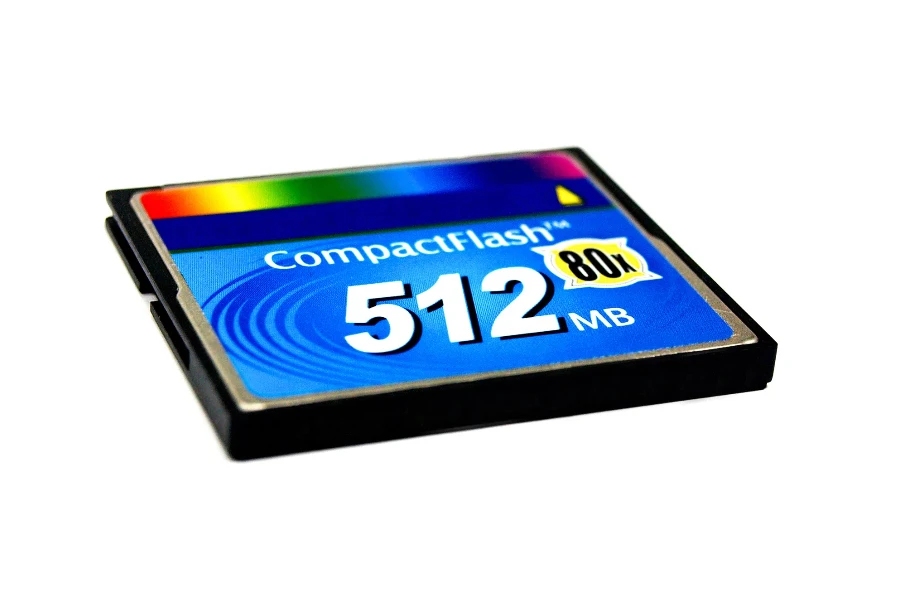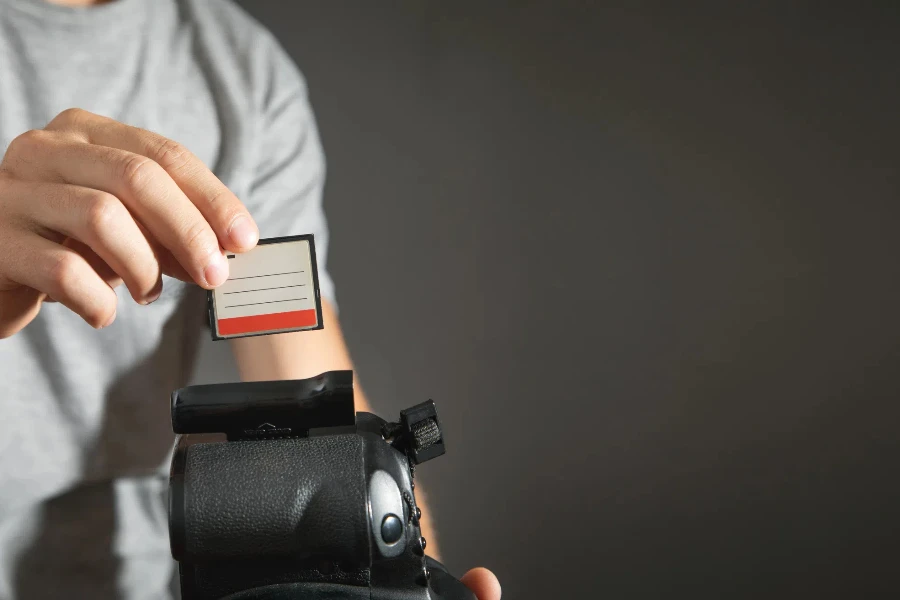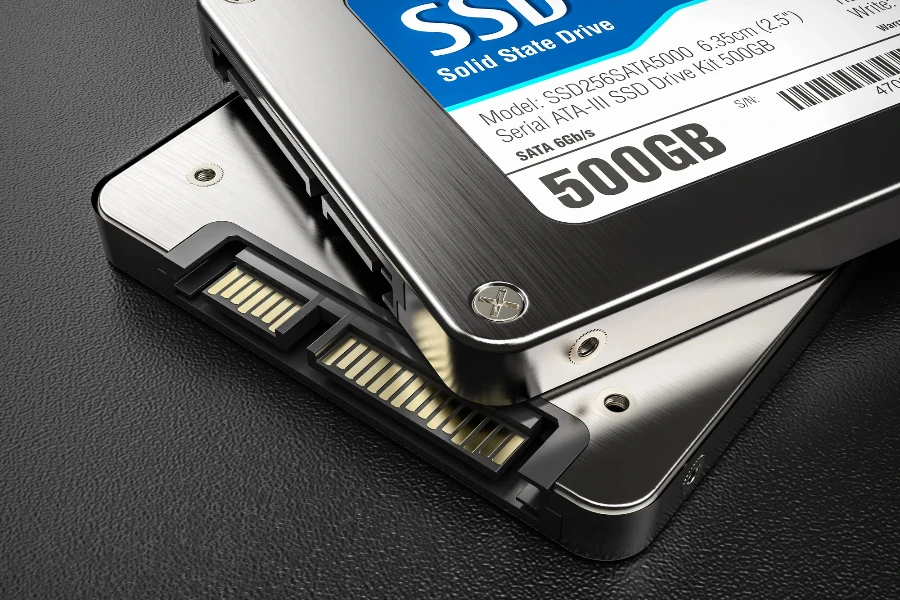As of 2024, the demand for Compact Flash cards is surging, fueled by innovations like CFexpress technology. This trend is reshaping global markets, presenting business buyers with opportunities to enhance their inventory. With a focus on reliability and speed, Compact Flash cards are becoming essential for professional photography and industrial applications. This article delves into the critical factors business buyers must consider when selecting Compact Flash cards, ensuring they align with the latest market dynamics and technological advancements.
Table of Contents:
– Global Market Dynamics of Compact Flash Cards
– Essential Factors in Selecting a Compact Flash Card
– Additional Considerations for Compact Flash Cards
– Conclusion
Global Market Dynamics of Compact Flash Cards

The Compact Flash card market, a part of the broader flash memory card industry, has seen significant growth recently. The global flash memory card market size reached US$ 8.8 billion in 2023 and is projected to reach US$ 12.7 billion by 2032, exhibiting a growth rate (CAGR) of 4.1% during 2023-2032. By 2024, the global flash memory card market is expected to reach major revenue milestones, driven by demand in regions like Asia-Pacific. This region leads in market share due to increased technological adoption. Compact Flash cards are experiencing a resurgence in niche markets such as professional photography and industrial applications, where their durability and high-speed data transfer are highly valued. The market is also responding to the rising need for reliable data storage solutions amid growing digitization across sectors, with key players investing heavily in research and development to enhance performance.
A detailed market analysis shows that although Compact Flash cards are not the largest segment, they remain crucial due to their robust performance. With high-speed read/write capabilities, these cards meet the demands of professional-grade equipment, distinguishing themselves from other formats like SD cards. Economic influences in the market include rising raw material costs and competitive pricing pressures from alternative storage solutions. Consumers increasingly prioritize reliability and speed over sheer capacity, aligning with technological advancements and the integration of these cards in high-end cameras and industrial equipment.
Recent innovations in the Compact Flash card market include CFexpress cards, which offer higher speeds and capacities suitable for 4K and 8K video recording. Environmental regulations are also shaping manufacturing practices, with companies using sustainable materials to meet stringent standards. The product lifecycle of Compact Flash cards is increasingly aligned with technological advances, ensuring their longevity and relevance in a rapidly evolving digital landscape. While distribution channels favor online sales for their global reach and convenience, offline sales remain strong in regions with less digital penetration.
Essential Factors in Selecting a Compact Flash Card

When choosing a Compact Flash (CF) card, consider several factors to ensure it meets your performance and device compatibility needs. These include technical specifications, device compatibility, storage capacity, durability, and price. Let’s explore these key aspects.
1. Technical Specifications
CF cards have various specifications that affect their performance. Key specifications include speed class, UDMA rating, and interface type. The speed class, indicated by numbers like 400x or 800x, shows the card’s minimum write speed. For example, a 400x card writes data at 60 MB/s. UDMA (Ultra Direct Memory Access) ratings, from UDMA 0 to UDMA 7, indicate data transfer speeds, with UDMA 7 supporting up to 167 MB/s. The interface type, either CF I or CF II, determines physical and electrical compatibility.
Some cards also feature VPG (Video Performance Guarantee) ratings, ensuring a minimum sustained write speed for high-quality video capture. For photographers and videographers, a high VPG rating can significantly enhance footage quality.
2. Compatibility with Devices
Device compatibility is crucial when selecting a CF card. Not all cards work with every device. High-end DSLR cameras and professional video cameras often require cards with higher speed classes and UDMA ratings. Before buying, check if the CF card is compatible with device. Manufacturers usually provide compatibility lists or recommendations.
3. Storage Capacity
Storage capacity is vital, especially for professionals handling large volumes of high-resolution images or video. CF cards range from 8GB to 512GB and beyond. The needed capacity depends on user requirements. For example, photographers shooting in RAW or videographers capturing 4K video need higher capacity cards to reduce card changes and data transfers.
Consider the balance between capacity and speed. Higher capacity cards may be slower if not matched with the right speed ratings. Choose a card offering both adequate storage and necessary speed for efficiency and workflow.
4. Durability and Build Quality
Durability is key, especially for professionals in harsh environments. CF cards are generally robust, but quality varies by brand and model. Cards for extreme conditions offer greater resistance to temperature changes, shock, and water—critical for outdoor photographers and videographers, ensuring data integrity and card longevity.
Some CF cards include protective features like a write-protect switch to prevent accidental data loss. Such features add security to data.
5. Price Considerations
Price is an important factor. CF card prices vary based on speed, capacity, and features. While cheaper options are tempting, investing in a high-quality card offers better performance, reliability, and longevity. Assess the card’s value relative to its price, considering speed, capacity, and durability.
For budget-conscious buyers, look for deals on reputable brands. Bulk purchases or seasonal sales can yield high-quality CF cards at lower prices. Balancing cost with performance needs ensures you get the best value for your investment.
Additional Considerations for Compact Flash Cards

Beyond fundamental factors, consider brand reputation, warranty, and after-sales support when choosing a CF card.
Brand reputation indicates quality and performance. Established brands like SanDisk, Lexar, and Transcend are known for high-quality memory solutions. These brands offer a range of CF cards for amateur and professional needs. Choosing a reputable brand reduces the risk of counterfeit products, which often have performance issues.
Most reputable CF card manufacturers offer warranties from one to five years, covering manufacturing defects. Understand warranty terms, as they vary by brand and model.
A responsive support team can assist with troubleshooting, replacements, or refunds. Checking reviews and forums provides insights into a brand’s customer support quality, aiding informed decisions.
The CF card industry is evolving, with new technologies enhancing performance and capabilities. Understanding these advancements helps buyers choose the best CF cards for their needs.
Enhanced Data Security Features
Recent CF card advancements include enhanced data security features, like hardware-based encryption and password protection. These are beneficial for professionals handling sensitive data, ensuring security even if the card is lost or stolen. Some CF cards offer secure erase functions, permanently deleting data.
These security features are increasingly important as data privacy concerns grow. Choosing a CF card with robust security measures provides peace of mind and protects against unauthorized data access.
Increased Speed and Performance Capabilities
Demand for faster data transfer rates has led to CF cards with increased speed and performance. CFexpress technology offers a significant leap, with read and write speeds far exceeding traditional CF cards. CFexpress cards use the PCIe interface, providing speeds up to 2,000 MB/s, ideal for high-resolution video and rapid burst photography.
For professionals needing top performance, CFexpress cards are a future-proof investment. Ensure the devices are compatible, as not all support CFexpress cards.
Advanced Durability and Environmental Resistance
As CF card use expands into demanding environments, manufacturers have developed cards with advanced durability and environmental resistance. These cards withstand extreme temperatures, humidity, and physical shocks, ensuring reliable performance in challenging conditions. Some models feature reinforced casings and advanced sealing to protect against dust and moisture.
For users in harsh environments, investing in a CF card with enhanced durability prevents data loss and extends the card’s lifespan. Check for certifications like IP ratings to ensure a card’s environmental resistance.
Conclusion
The demand for Compact Flash cards is on the rise, driven by their essential role in high-speed professional applications and the advancement of CFexpress technology. Business buyers must carefully consider compatibility, capacity, and durability to meet the needs of a technologically evolving market. These cards are becoming increasingly vital for those seeking reliable, high-performance storage solutions in challenging environments.




